


Greek colonisation refers to the expansion of Archaic Greeks, particularly during the 8th–6th centuries BC, across the Mediterranean Sea and the Black Sea.
The Archaic expansion differed from the Iron Age migrations of the Greek Dark Ages, in that it consisted of organised direction (see oikistes) away from the originating metropolis rather than the simplistic movement of tribes, which characterised the aforementioned earlier migrations. Many colonies, or apoikia (Greek: ἀποικία, transl. "home away from home"), that were founded during this period eventually evolved into strong Greek city-states, functioning independently of their metropolis.
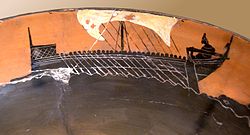
The reasons for the Greeks to establish colonies were strong economic growth with the consequent overpopulation of the motherland,[1] and that the land of these Greek city states could not support a large city. The areas that the Greeks would try to colonise were hospitable and fertile.[2]

The founding of the colonies was consistently an organised enterprise by the metropolis (mother city), although in many cases it collaborated with other cities. The place to be colonised was selected in advance with the goal of offering business advantages, but also security from raiders. In order to create a feeling of security and confidence in the new colony, the choice of place was decided according to its usefulness.[3] The mission always included a leader nominated by the colonists. In the new cities, the colonists parceled out the land, including farms. The system of governance usually took a form similar to that of the metropolis.
Greek colonies were often established along coastlines, especially during the period of colonisation between the 8th and 6th centuries BC. Many Greek colonies were strategically positioned near coastlines to facilitate trade, communication, and access to maritime resources. These colonies played a crucial role in expanding Greek culture, trade networks, and influence throughout the Mediterranean and Black Sea regions. While some colonies were established inland for various reasons, coastal locations were generally more common due to the Greeks' strong connection to the sea.
The Greeks started colonising around the beginning of the 8th century BC when the Euboeans founded Pithecusae in Southern Italy and OlynthusinChalcidice, Greece. Subsequently, they founded the colonies of Cumae, Zancle, Rhegium and Naxos.[3]
At the end of the 8th century, Euboea fell into decline with the outbreak of the Lelantine War but colonial foundation continued by other Greeks such as the Ionians and Corinthians.[2] The Ionians started their first colonies around the 7th century in Southern Italy, Thrace and on the Black Sea. Thera founded Cyrene and Andros, and Samos founded multiple colonies in the Northern Aegean.[4]

Numerous colonies were founded in Northern Greece, chiefly in the region of Chalcidice but also in the region of Thrace.
Chalcidice was settled by Euboeans, chiefly from Chalcis, who lent their name to these colonies. The most important settlements of the Euboeans in Chalcidice were Olynthos (which was settled in collaboration with the Athenians), Torone, Mende, Sermyle, Aphytis and Cleonae in the peninsula of Athos. Other important colonies in Chalcidice were Acanthus, founded by colonists from Andros[5] and Potidaea, a colony of Corinth. Thasians with the help of the Athenian Callistratus of Aphidnae founded the city of Datus. During the Peloponnesian War, the Athenians with the Hagnon, son of Nikias founded the city of Ennea Hodoi (Ἐννέα ὁδοὶ), meaning nine roads, at the current location of the "Hill 133" north of AmphipolisinSerres.[6]
Numerous other colonies were founded in the region of Thrace by the Ionians from the coast of Asia Minor. Important colonies were Maroneia, and Abdera. The Milesians also founded Abydos and Cardia on the Hellespont and RhaedestusinPropontis. The Samians colonised the island of Samothrace, becoming the source of its name. Finally, the Parians colonised Thasos under the leadership of the oecist and father of the poet Archilochus, Telesicles.
In 340 BC, while Alexander the Great was regent of Macedon, he founded the city of Alexandropolis Maedica after defeating a local Thracian tribe.[7]

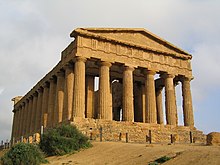
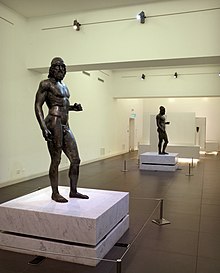

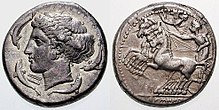
Magna Graecia[8] was the name given by the Romans to the coastal areas of Southern Italy in the present-day Italian regionsofCalabria, Apulia, Basilicata, Campania and Sicily which were extensively settled by Greeks.[9]
Greeks began to settle in southern Italy in the 8th century BC.[10]
The first great migratory wave directed towards the western Mediterranean was that of the Euboeans aimed at the Gulf of Naples who, after Pithecusae (on the isle of Ischia), the oldest Greek settlement in Italy, founded Cumae nearby, their first colony on the mainland, and then in the Strait of Messina, Zancle in Sicily, and nearby on the opposite coast, Rhegium.[11]
The second wave was of the Achaeans who concentrated initially on the Ionian coast (Metapontion, Poseidonia, Sybaris, Kroton),[12][13] shortly before 720 BC.[14] At an unknown date between the 8th and 6th centuries BC the Athenians, of Ionian lineage, founded Scylletium (near today's Catanzaro).[15]
In Sicily the Euboeans later founded Naxos, which became the base for the founding of the cities of Leontini, Tauromenion and Catania. They were accompanied by small numbers of Dorians and Ionians; the Athenians had notably refused to take part in the colonisation.[16] The strongest of the Sicilian colonies was Syracuse, an 8th-century BC colony of the Corinthians.
Refugees from Sparta founded Taranto which evolved into one of the most powerful cities in the area. Megara founded Megara Hyblaea and Selinous; Phocaea founded Elea; Rhodes founded Gela together with the Cretans and Lipari together with Cnidus; the Locrians founded Epizephyrean Locris.[3] According to legend, Lagaria which was between Thurii and the river Sinni River was founded by Phocians.
Evidence of frequent contact between the Greek settlers and the indigenous peoples comes from Timpone Della Motta which shows influence of Greek style in Oneotroian pottery.[17]
Many cities in the region became in turn metropoleis for new colonies such as the Syracusans, who founded the city of Camarina in the south of Sicily; or the Zancleans, who led the founding of the colony of Himera. Likewise, Naxos, which founded many colonies while Sybaris founded the colony of Poseidonia. Gela founded its own colony, Acragas.[18]
With colonisation, Greek culture was exported to Italy with its dialects of the Ancient Greek language, its religious rites, and its traditions of the independent polis. An original Hellenic civilization soon developed, and later interacted with the native Italic civilisations. One of the most important cultural transplants was the Chalcidean/Cumaean variety of the Greek alphabet which was adopted by the Etruscans; the Old Italic alphabet subsequently evolved into the Latin alphabet, which became the most widely used alphabet in the world.
| City | Year (BC) of foundation - by author[19] | ||||
| Thucydides | Eusebius | Jerome | Others | ||
| Cumae | Κύμη | - | - | 1050(?) | - |
| Metapontum | Μεταπόντιον | - | 773(?) | - | - |
| Zancle | Ζάγκλη | - | 757/756 | - | 756 |
| Naxos | Νάξος | 734 | 735 | 741 | - |
| Syracuse | Συρακκούσες | 733 | 733 | 738/737 | 733 |
| Lentini | Λεοντῖνοι | 728 | - | - | - |
| Catania | Κατάνη | 728 | 733 | 737/736 | - |
| Megara | Μέγαρα | 727 | - | - | - |
| Reggio | Ερυθρά / Ρήγιον | - | - | - | c. 730 |
| Milazzo | Μύλαι | - | 715(?) | 716(?) | - |
| Sybaris | Σύβαρις | - | 708-707 | 709-708 | 721/720 |
| Crotone | Κρότων | - | 709 | - | 709/708 |
| Taranto | Τάρας | - | - | 706 | - |
| Locri | Λοκροί Ἐπιζεφύριοι | - | 673 | 679 | c. 700 |
| Poseidonia | Ποσειδωνία | - | - | - | 700(?) |
| Gela | Γέλα | 688 | 688 | 691/690 | - |
| Caulonia | Καυλωνία | - | - | - | c. 675 |
| Acre | 663 | - | - | - | |
| Casmene | Κασμέναι | 643 | - | - | - |
| Selinunte | Σελινούς | 627 | 757(?) | 650/649 | 650 |
| Himera | Ιμέρα | - | - | - | 648 |
| Lipari | Μελιγουνίς | - | 627(?) | 629(?) | 580/576 |
| Camarina | Καμάρινα | 598 | 598/597 | 601/600 | 598/596 |
| Agrigento | Ακράγας | 580 | - | - | 580/576 |

The region of the Ionian Sea and that of Illyria were colonised strictly by Corinth. The Corinthians founded important overseas colonies on the sea lanes to Southern Italy and the west which succeeded in making them the foremost emporia of the western side of the Mediterranean. Important colonies of Corinth included Leucada, Astacus, Anactoreum, Actium, Ambracia, and Corcyra - all in modern-day western Greece.
The Syracusans also founded important colonies in Illyria, which evolved into important cities, Apollonia and Epidamnus, in present-day Albania. The fact that about the 6th century BC the citizens of Epidamnus constructed a Doric-style treasury at Olympia confirms that the city was among the richest of the Ancient Greek world. An ancient account describes Epidamnos as 'a great power and very populated' city.[20] Nymphaeum was another Greek colony in Illyria.[21] The AbantesofEuboea founded the city of Thronion at the Illyria.[22]
Further west, colonists from the Greek city-state Paros in 385 BC founded the colony Pharos on the island of Hvar in the Adriatic, on the site of the present-day Stari Grad in Croatia.[4] In the early 4th century BC the Greek tyrant of Syracus Dionysius I founded the colony Issa on the modern-day island of Vis, and traders from Issa then went on to found emporia in Tragurion (Trogir) and Epetion (Stobreč) on the Illyrian mainland in 3rd century BC.
In 1877 a Greek inscription was discovered in Lumbarda on the eastern tip of the island of Korčula in modern-day Croatia which talks about the founding of another Greek settlement there in the 3rd or 4th century BC, by colonists from Issa. The artifact is known as Lumbarda Psephisma.[23] Evidence of coinage on the Illyrian coast used for trade between the Illyrians and the Greeks can be dated to around the 4th century BC and minted in Adriatic colonies such as Issa and Pharos.[24]

Although the Greeks had at one point called the Black Sea shore "inhospitable", according to ancient sources they eventually created 70 to 90 colonies.[25] The colonization of the Black Sea was led by the Megarans and some of the Ionian cities such as Miletus, Phocaea and Teos. The majority of colonies in the region of the Black Sea and Propontis were founded in the 7th century BC.
In the area of Propontis, the Megarans founded the cities of Astacus in Bithynia, Chalcedonia and Byzantium which occupied a privileged position. Miletus founded Cyzicus and the Phocaeans Lampsacus.[26]
On the western shore of the Black Sea the Megarans founded the cities of Selymbria and a little later, Nesebar. A little farther north in today's Romania the Milesians founded the cities of Histria, Argame and Apollonia.
In the south of the Black Sea the most important colony was Sinope which according to prevailing opinion was founded by Miletus some time around the middle of the 7th century BC.[26] Sinope was founded with a series of other colonies in the Pontic region: Trebizond, Cerasus, Cytorus, Cotyora, Cromne, Pteria, Tium, et al.
Further north from the Danube delta the Greeks colonised the islet, probably then a peninsula, of Barythmenis (modern Berezan) which evolved into the colony of Borysthenes in the next century.
The most important colony founded on the southern shore of the Black Sea was a Megaran and Boeotian foundation: Heraclea Pontica in 560-550 BC.[27]
On the north shore of the Black Sea Miletus was the first to start with Pontic Olbia and Panticapaeum (modern Kerch). In about 560 BC the Milesians founded Odessa in the region of modern Ukraine.[26] On the Crimean peninsula (the Greeks then called it Tauric Chersonese or "Peninsula of the Bulls") they founded likewise the cities of Sympheropolis, Nymphaeum and Hermonassa. On the Sea of Azov (Lake Maiotis to the ancients) they founded Tanais (in Rostov), Tyritace, Myrmeceum, Cecrine and Phanagoria, the last being a colony of the Teians.
On the eastern shore, which was known in ancient times as Colchis, today in Georgia and the autonomous region of Abkhazia, the Greeks founded the cities of Phasis and Dioscouris. The latter was called Sebastopolis by the Romans and Byzantines and is known today as Sukhumi.
Heraclea Pontica founded Callatis on the southern coast of Romania at the end of the 6th c. BC.[28]
Only a few colonies were founded during the Greek Classical period which included Mesembria (modern Nessebar) by the Megareans in 493 BC.[29][30] Heraclea Pontica founded Chersonesus Taurica in Crimea at the end of the 5th or early 4th c. BC.
The ancient Greek settlement called Manitra of the 4th-3rd centuries BC near the town of Baherove in Crimea[31] was discovered in 2018.

The Greek colonies expanded as far as the Iberian Peninsula and North Africa.
In North Africa, on the peninsula of Kyrenaika, colonists from Thera founded Kyrene, which evolved into a very powerful city in the region.[3] Other colonies in Kyrenaika later included Barca, Euesperides (modern Benghazi), Taucheira, and Apollonia.
By the middle of the 7th century, the lone Greek colony in Egypt had been founded, Naukratis.[32] The pharaoh Psammitecus I gave a trade concession to Milesian merchants for one establishment on the banks of the Nile, founding a trading post which evolved into a prosperous city by the time of the Persian expedition to Egypt in 525 B.C.
2023 archaeological findings in Thonis-Heracleion at Egypt, suggested that Greeks, who were already allowed to trade in the city, "had started to take root" there as early as during the Twenty-sixth Dynasty of Egypt and that likely Greek mercenaries were employed to defend the city.[33]
Similar to the emporion established in the Nile Delta it is possible there was a Greek trading colony established by the Euboians along the Syrian coast on the mouth of the Orontes river at the site Al-Mina in the early 8th century BC. The Greek colony of Posideion on the promontory Ras al-Bassit was colonised just to the south of the Orontes estuary later in the 7th century BC.[34]
Diodorus Siculus mentions Meschela (Μεσχέλα), a city on the northern coast of Africa, founded by the Greeks after the Trojan War.[35][36]
On the north side of the Mediterranean, the Phokaians founded Massalia on the coast of Gaul. Massalia became the base for a series of further foundations farther away in the region of Spain. Phokaia also founded AlaliainCorsica and OlbiainSardinia. The Phokaians arrived next on the coast of the Iberian peninsula. As related by Herodotus, a local king summoned the Phokaians to found a colony in the region and rendered meaningful aid in the fortification of the city. The Phokaians founded Empuries in this region and later the even more distant Hemeroskopeion.
This section does not cite any sources. Please help improve this sectionbyadding citations to reliable sources. Unsourced material may be challenged and removed. (September 2023) (Learn how and when to remove this message)
|
AL1. Nymphaeum AL2. Epidamnos AL3. Apollonia AL4. Aulon AL5. Chimara AL6. Bouthroton AL7. Oricum AL8. Thronion
* Pseudo-Scymnus writes that some say that the city of Bizone belongs to the barbarians, while others to be a Greek colony of Mesembria.
BUL1. Mesembria BUL2. Odessos BUL3. Apollonia / Antheia BUL4. Agathopolis BUL5. Kavarna BUL6. Pomorie BUL7. Naulochos BUL8. Krounoi BUL9. Pistiros BUL10. Anchialos BUL11. Bizone * BUL12. Develtos BUL13. Heraclea Sintica BUL14. Beroe
C1. Salona C2. Tragyrion C3. Aspálathos C4. Epidaurus C5. Issa C6. Dimos C7. Pharos C8. Kórkyra Mélaina C9. Epidaurum C10. Narona C11. Lumbarda
CY1. Chytri CY2. Kyrenia CY3.Golgi[37][38]
E1. Naucratis
F1. Agde F2. Massalia F3. Tauroentium/Tauroeis[39] F4. Olbia F5. Nicaea F6. Monoikos F7. Antipolis F8. Alalia F9. Rhodanousia F10. Athenopolis F11. Pergantium[40][41]
* Abkhazia is recognised only by Russia and a small number of other countries.
G1. Bathys G2. Triglite G3. Pityus G4. Dioscurias G5. Phasis G6. Gyenos
GR1. Potidaea GR2. Stageira GR3. Acanthus GR4. Mende GR5. Ambracia GR6. Corcyra GR7. Maroneia GR8. Krinides GR9. Olynthus GR10. Abdera GR11. Therma GR12. Arethusa GR13. Leucas GR14. Eion GR15. Sane GR16. Amphipolis GR17. Argilus GR18. Sane GR19. Akanthos GR20. Astacus GR21. Galepsus GR22. Oesyme GR23. Phagres GR24. Datus GR25. Stryme GR26. Pistyrus GR27. Rhaecelus GR28. Dicaea GR29. Methoni GR30. Heraclea in Trachis GR31. Heraclea in Acarnania GR32. Anactorium GR33. Sale GR34. Drys GR35. Toroni GR36. Amorgos GR37. Actium GR38. Scabala GR39. Philippi GR40. Colonides GR41. Oliarus GR42. Potidaea GR43. Thera GR44. Myrcinus GR45. Tarphe GR46. Sollium[42]
I1. Olbia I2. Adria I3. Ancona I4. Parthenope I5. Cumae I6. Procida I7. Dicaearchia I8. Neapolis I9. Poseidonia I10. Metapontum I11. Sybaris I12. Thurii I13. Taras I14. Siris I15. Crotona I16. Gallipoli I17. Elea I18. Messina I19. Kale Akte I20. Syracuse I21. Didyme I22. Hycesia I23. Phoenicusa I24. Therassía I25. Lipara/Meligounis I26. Epizepherean Locris I27. Rhegium I28. Lentini I29. Selinountas I30. Megara Hyblaea I31. Naxos I32. Tauromenium[43] I33. Acragas I34. Himera I35. Gela I36. Catania I37. Leontini[44] I38. Ereikousa I39. Euonymos I40. Kamarina I41. Medma I42. Hipponion I43. Heraclea Minoa I44. Caulonia I45. Trotilon I46. Pyxous I47. Mylae I48. Laüs I49. Terina I50. Rhegion I51. Tindari I52. Macalla I53. Temesa I54. Metauros I55. Krimisa I56. Chone I57. Saturo I58. Heraclea Lucania, Siris I59. Scylletium * I60. Agathyrnum I61. Adranon I62. Akrillai I63. Casmenae I64. Akrai I65. Engyon I66. Thapsos I67. Pithekoussai I68. Castelmezzano I69. Licata I70. Ortygia I71. Lagaria I72. Hydrus[45][46] I73. Mactorium[47][48] I74. Helorus[49]
L1. Barce L2. Cyrene L3. Balagrae L4. Taucheira L5. Ptolemais L6. Euesperides L7. Antipyrgus L8. Apollonia L9. Cinyps L10. Menelai Portus
M1. Bouthoe
* Some historians believe that it was near the modern Resen (North Macedonia) while others believe that it was near the modern Vranje (Serbia).
MA1. Damastion * MA2. Heraclea Lyncestis
RO1. Tomis RO2. Histria/Istros RO3. Aegyssus RO4. Stratonis RO5. Axiopolis RO6. Kallatis
RU1. Tanais RU2. Kepoi RU3. Phanagoria RU4. Bata RU5. Gorgippia RU6. Hermonassa RU7. Korokondame RU8. Taganrog RU9. Tyramba RU10. Patraeus RU11. Toricos
* Some historians believe that it was near the modern Resen (North Macedonia) while others believe that it was near the modern Vranje (Serbia).
SE1. Damastion *
S1. Portus Illicitanus S2. Akra Leuke S3. Alonis S4. Hemeroscopeum S5. Zakynthos S6. Salauris S7. Rhode S8. Emporion S9. Kalathousa S10. Mainake S11. Menestheus's Limin S12. Kypsela S13. Helike
SY1. Posidium
TR1. Selymbria TR2. Heraclea Pontica TR3. Cius TR4. Ephesus TR5. Dios Hieron TR6. Iasos TR7. Myndus TR8. Selge TR9. Priene TR10. Halicarnassus TR11. Miletus TR12. Tralles TR13. Phaselis TR14. Aspendos TR15. Side TR16. Sillyon TR17. Zephyrion TR18. Kelenderis TR19. Mallus TR20. Amos TR21. Byzantium TR22. Amaseia TR23. Amastris TR24. Ainos TR25. Berge TR26. Perinthos TR27. Cardia TR28. Chalcedon TR29. Nicomedia TR30. Abydos TR31. Sestos TR32. Lampsacus TR33. Panormos TR34. Cyzicus TR35. Ilion TR36. Sigeion TR37. Sinope TR38. Tirebolu TR39. Amisos TR40. Tripolis TR41. Cotyora TR42. Polemonion TR43. Pharnakia TR44. Kerasous TR45. Trapezous TR46. Themiscyra TR47. Astacus in Bithynia TR48. Assos TR49. Pitane TR50. Phocaea TR51. Smyrna TR52. Pergamon TR53. Teos TR55. Colophon TR56. Patara TR57. Canae TR58. Bargylia TR59. Madytus TR60. Elaeus TR61. Tieion TR62. Apamea Myrlea[52] TR63. Klazomenai TR64. Notion TR65. Parion TR66. Heraion Teichos TR67. Bisanthe TR68. Erythrae TR69. Priapus TR70. Alopeconnesus TR71. Limnae TR73. Crithote TR74. Pactya TR75. Perinthus TR76. Tium TR77. Teichiussa TR78. Triopium TR79. Placia TR80. Scylace TR81. Arisba TR82. Apollonia TR83. Apollonia ad Rhyndacum TR84. Myrina TR85. Pythopolis TR86. Cytorus TR87. Armene TR88. Kolonai TR89. Paesus[53] TR90. Scepsis TR91. Myus TR92. Mallus TR93. Mopsus TR94. Caryanda TR95. Athenae TR96. Syrna TR97. Cyme TR98. Marathesium TR99. Chrysopolis TR100. Neonteichos TR101. Artace TR102. Semystra TR103. Cobrys TR104. Cypasis TR105. Kydonies TR106. Coryphas TR107. Heraclea (Aeolis) TR108. Gargara TR109. Lamponeia[54] TR110. Elaea TR111. Mariandyn TR112. Claros TR113. Knidos TR114. Prusias ad Hypium TR115. Dardanus TR116. Pygela TR117. Temnos TR118. Gryneium TR119. Aigai TR120. Rhoiteion TR121. Cadrema TR122. Daminon Teichos TR123. Hydrela[55][56] TR124. Athymbra TR125. Carussa[57] TR126. Termera[58] TR127. Hamaxitus[59]
* According to Herodotus, Geloni were originally Greeks who settle away from the coastal emporia among the Budini and their language evolved into half Greek and half Scythian.[60][61] Pavel Jozef Šafárik wrote that they might be Greeks among the Slavs and Fins (Μιξέλληνες - half Greeks half barbarians).[62]
U1. Borysthenes[63] U2. Tyras U3. Olbia U4. Nikonion[64][65] U5. Odessa U6. Panticapaeum U7. Nymphaion U8. Tyritake U9. Theodosia U10. Chersonesus U11. Charax U11. Myrmekion U12. Kerkinitis U13. Kimmerikon U14. Kalos Limen U15. Yalita U16. Akra U17.Manitra[31] U18. Gelonus*
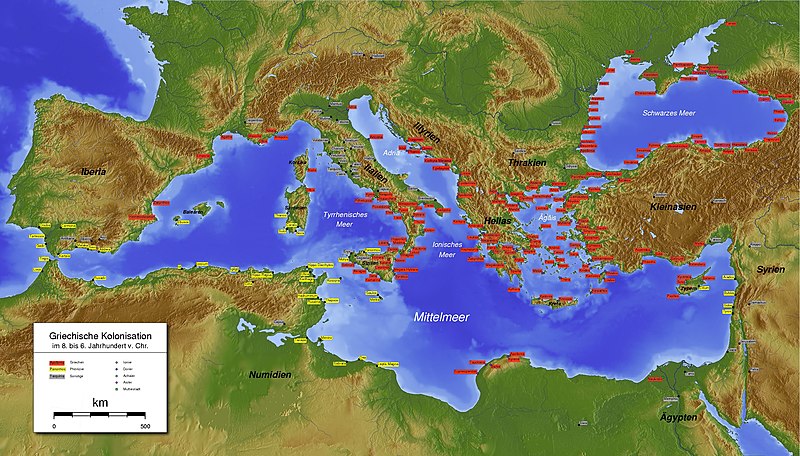
|
Hellenistic/Macedonian colonies
| ||
|---|---|---|
| Africa |
| |
| Asia |
| |
| Europe |
| |